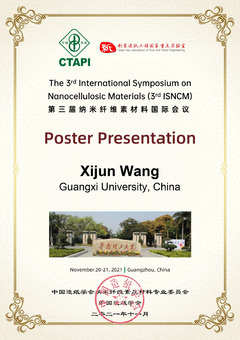Extraction of cellulose nanofibrils by the synergistic effect of ball milling and chemical modification
ID:96
Submission ID:124 View Protection:PRIVATE
Updated Time:2021-11-15 17:35:57 Hits:991
Poster Presentation
Abstract
Currently, ball milling is widely used for the preparation of nanoparticles because of its simple operation, environmentally friendly, low-cost and its broad applicability to most types of biomasses. Besides, it easily produces nanoparticles in large quantities at room temperature and pressure compare to other mechanical treatments. Cellulose nanofibrils (CNFs) extracted from ball milling has been reported previously. However, CNFs prepared from only machinal methods cause a high energy consumption. Hence, ball milling combines with chemical modification was proposed to fabricate CNFs. Sulfated cellulose nanofibrils from the esterification reaction in a heterogeneous system of sulfamic acid and N'N-Dimethylformamide (DMF) had been reported. However, a large amount of DMF was used to swelling the cellulose, resulting in an environmental pollution. In this study, three kinds of biomass waste were first swelled with a little amount of DMF and then was ball milling with sulfamic acid. The properties and the surface morphology of CNFs were extensively investigated. Besides, the ball milling conditions was further investigated on the effect of CNFs. The peak at 1230 cm-1 on the spectrums of Fourier transform infrared spectroscopy is associate to the asymmetrical vibration of O=S=O, which indicated the success of sulfation on cellulose. The result of thermogravimetric showed a good thermal stability of both the raw cellulose and CNFs and the decomposition temperature was about 285 °C. Besides, the X-ray diffraction showed a typical crystal form of Ⅰ for both raw cellulose and CNFs. In addition, the CNFs exhibited a high zeta potential of about -50 mV in the value of pH=7, indicating a high colloidal stability in aqueous environments. Different to the single nanofibril prepared by other methods, a network fibril was observed in this work. All of the CNFs showed a uniform height of 2-4 nm and the length was over than 1μm, which means a large aspect ratio and can be used for composite enhancement. The morphology of atomic force microscope showed that the effect of ball milling increased with the milling time, molar ratio, and milling speed. Moreover, the degree of substitution and the degree of polymerization also can be tailored by the ball milling conditions. The current research provided a potential approach to prepared sulfation cellulose nanofibrils at a relative low energy consumption and environmental pollution in large quantities.
Keywords
cellulose, nanofibrils, ball milling, sulfation, synergistic
Submission Author
Haisong Qi
South China University of Technology
宝凤 林
广西大学
Xijun Wang
Guangxi university



Comment submit